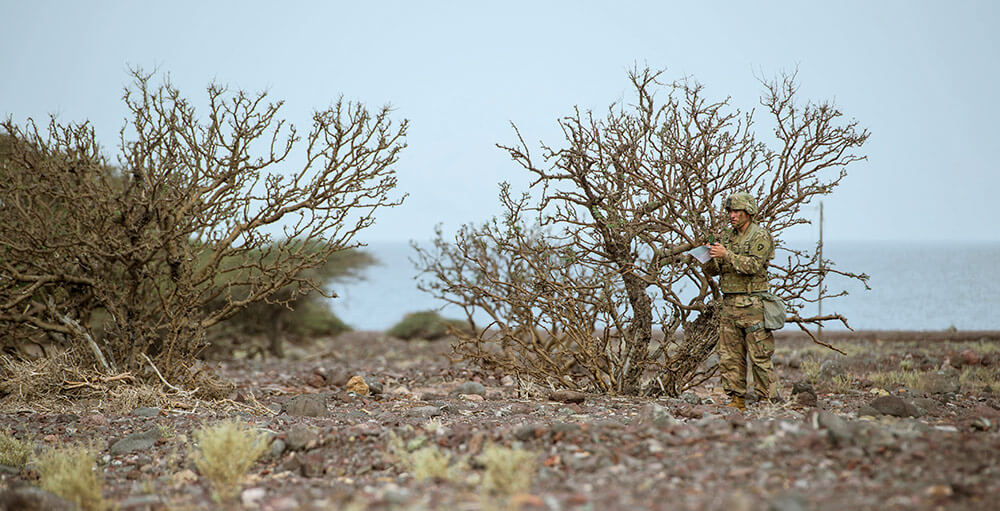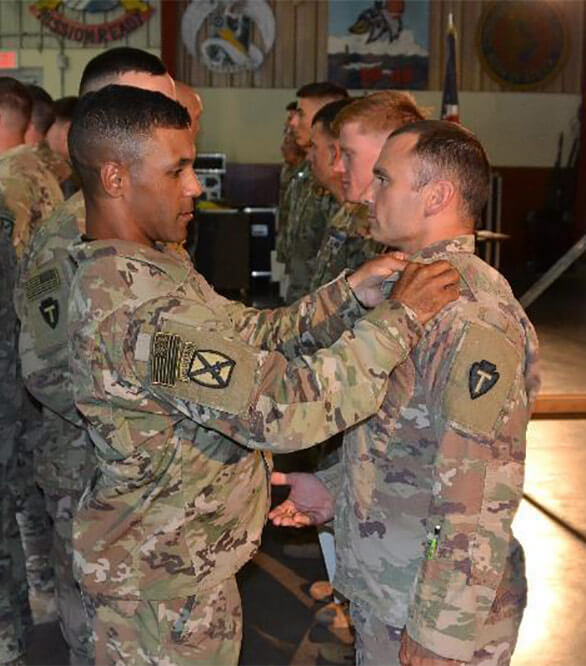Texas Guard Soldiers Earn EIB in Africa
LTC Ross Walker referred to the badge as the mark of an expert in the profession. SGT Kyle Parrin said the badge in the infantry world is a statement – one that denotes proficiency. MSG Donnie Bosley simply called it the “covenant badge.”

These Texas Army National Guard Soldiers of the Third Battalion, 144th Infantry Regiment, were assigned to the Combined Joint Task Force – Horn of Africa at Camp Lemonnier, Djibouti. In January and February of this year, while still deployed to Djibouti, the battalion tested its Soldiers for the Expert Infantryman Badge (EIB) – an infrequent opportunity for Army National Guard Soldiers.
The EIB was developed in 1944 to promote esprit de corps within U.S. infantry troops. It recognizes infantry and Special Forces Soldiers who demonstrate a mastery of core infantry skills.
“Earning the EIB is what every Infantryman should [strive for], “ said CSM Clinton Petty. CSM Petty is assigned to Task Force Bayonet and is the unit’s senior enlisted leader and EIB board president.
“It indicates you are an expert in your MOS’ individual tasks,” he said. “When you are a leader of Soldiers, they must have confidence in your abilities, and having an EIB shows them you have mastered the basic skills.”
1LT Wesley Hall, with Headquarters and Headquarters Company, was even more emphatic about the meaning of the badge.
“This individual award raises pride and esprit de corps within the branch and for every individual who earns it. The training value, even for those who do not make it through testing to earn EIB, is intangible. Our Infantrymen will be better at individual tasks required of them in training and resilient during collective training events. That is the most important factor to me – increasing the lethality and proficiency of our force.”
Earning the EIB requires Infantrymen to successfully complete four phases.
The first phase calls for the passing of the APFT with a score of at least 80 points in each event. The score of 80 must be achieved the first time, as the test cannot be retaken for the EIB. The next phase is land navigation. In this phase, three-out-of-four points must be earned through completion of both day and night exercises. A ”GO” means moving on to the next phase of the examination.
The third phase is made up of testing stations – 30 testing stations to be exact. One Texas Army National Guard participant noted this phase as the most difficult part of the challenge.
“It is difficult to describe the level of focus and determination necessary to successfully execute these tasks to standard,” said 1SG Jonathan Hendrix of the 3-144th’s D Company. “While the road march is grueling, especially in Djibouti, most Infantrymen can fight through the physical adversity. But the mental strain that comes with executing 30 tasks without deficiency is incredible.”
SPC Joshua Geesling, also of D Company, noted that he overcame the mental stress presented by the testing stations by identifying the tasks in which he was weakest and practicing them repeatedly until he discovered, and corrected, his points of failure. In that way, he could mitigate surprises during actual testing, he said.
“I made sure to stay humble and realize I very well might not make it through test week,” he explained. “Staying humble pushed me to work even harder to further the possibility of earning the badge.”
The 30 testing stations included 10 medical stations, 10 weapons stations and 10 patrol procedures stations. The station types are chosen by the unit’s leadership from 45 possibilities, with multiple tasks expected for each station. Tasks are required to be performed flawlessly, without misstep or error. If not, the testing Soldier receives a “NO-GO.” One double “NO-GO” on a single task, or three total “NO-GOs,” eliminates the EIB candidate from completing the course.

While some felt the testing stations were the most challenging segment of the evaluation, others noted the fourth and final phase as the most trying.
“No matter how much you train, a 12-mile road march will always be a feat of strength that requires a tremendous amount of grit,” said 1LT Kevin Gillespie.
MSG Bosley commented on the heightened planning that went into ensuring Soldiers’ safety during the strenuous march through the desert.
“Djibouti in May – it is very humid and hot,” he said. “The road march was not only extremely challenging for the 24 candidates that made it that far, but it had a lot of risks that took the medical platoon, EIB cadre and command getting into meticulous details to mitigate as much risk as possible. All together, we had 45 EIB cadre at the event – all of the company and task force leadership, 16 medics, two doctors, two field litter ambulances, the medical platoon sergeant on a roving bicycle, six immersion troughs, 12 manned checkpoints and a fruit stand lining the 3-mile route the candidates had to complete four times at 0300 in the morning.”
LTC Walker, commander of Task Force Bayonet, said 144th leadership decided well before arriving in Djibouti that they would execute an EIB event while deployed. The decision was based on two main factors. The first and foremost being that it would provide a level of increased readiness to the individual Soldiers, and by extension, to the entire organization. The second determining factor had to do with taking advantage of the timing and environment available to the battalion while at Camp Lemonnier. Finding the consecutive training days to conduct a two-week train-up and one-week test in the Army National Guard is rare and costly.
“We have a captive audience here with minimal distractors,” he noted.

Planning, constructing and grading the EIB course was a massive undertaking. The over four weeks of prep time that went into the five-day event required participation from all available personnel – including some from other components and military services. The 3-144th had help from both the active duty Soldiers of the 10th Mountain Division, and the seamen of the Navy Seabees (Naval construction battalions), who played a vital role in construction.
“As is normally the case in any joint environment, successful execution of an operation depends on the ability and willingness of the different services to work together toward a common goal,” commented 1SG Hendrix of D Company. “The Seabees were an excellent partner in helping to achieve our goals during the EIB competition. No matter how large or small the request, they came through for us and really allowed us to transform our patch of desert into a training site that is on par with many CONUS EIB sites. Our attached 10th Mountain Division companies were decisive to our ability to conduct the competition. Without both their EIB cadre members as well as their sheer manpower, we would have been hard-pressed to put together this event.”
1SG Hendrix recalled a few specifics of creating the EIB course.
“As soon as we landed in country and completed our RIP [Relief in Place/Transfer of Authority], just before Thanksgiving, we began focusing our efforts toward building the EIB site and compiling all of the supplies necessary to effectively train [several hundred] candidates. We moved our operation out to the EIB site, commonly known as the French Notch, during the last week in December. We spent roughly four weeks setting up the lanes. We filled and placed around 3,000 sand bags, erected close to 40 camo nets and built 30 benches, five sand tables and 15 weapons/casualty platforms.”

Over two iterations of evaluations, approximately 300 Soldiers went through the EIB course – 68 successfully overcame the challenges of each phase and gained their EIB. Those who earned the covenant badge have attained a distinction held in high regard amongst both Infantrymen and other Army personnel alike. More importantly, the experience of testing for the EIB has helped all of the participating Soldiers to increase their knowledge base and refine their skills.
1LT Hall noted, “As a leader, it is important to demonstrate tactical and technical proficiency. [Because of the EIB course,] these skills are so well rehearsed and proven that when the time comes for company command weapons qualification and maneuver training, I am fully capable of carrying my own and leading from the front.”
Reflecting back over the earning of his EIB, 1LT Hall summarized the experience by saying, “This is absolutely the pinnacle of achievements I have had in the National Guard. Other training events I have completed did not require the amount of physical grit and intestinal fortitude required to earn EIB. It was truly earned through hard work. It is special as a National Guard Soldier because the opportunity is so rare.”
BY STAFF WRITER Matthew Liptak





